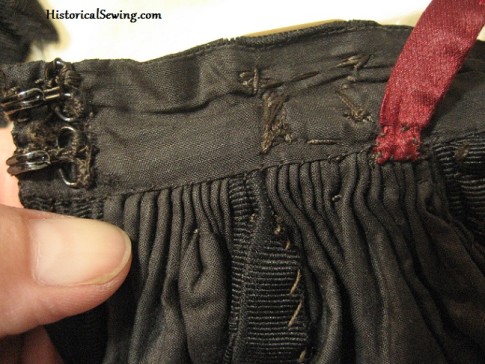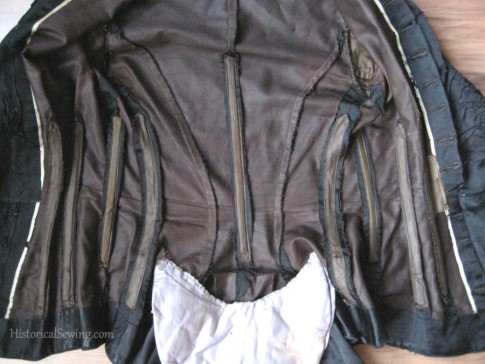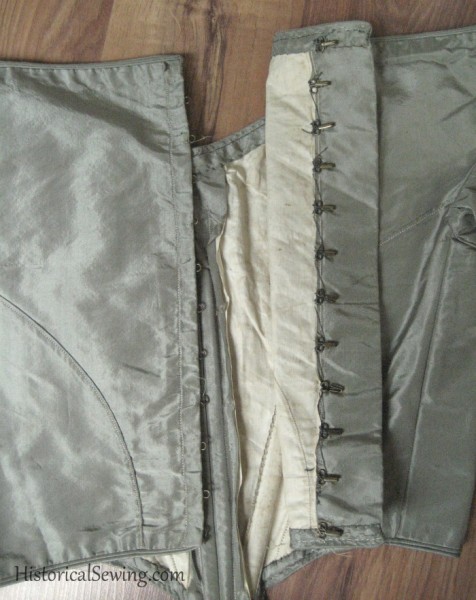
It’s a most wonderful thing to study antique garments then create your own reproduction based on your research! Our ancestors were wise when it came to sewing up their clothing.
But then again…. It was only their clothing.
We modern day costumers look at antiques with such reverence. We want to know their secrets. How they sewed a seam or finished a trim or pleated a ruffle.
So at what point does the admiration become obsession that even our own creativity suffers for it?

In my opinion: Be careful when trying to duplicate a garment from a scaled pattern printed in a book or an existing garment down to the stitches and fabrics. I believe this staunches the flow of our own individual creativity existing today with our current skills and available materials (and even budget for that matter).
Be aware, especially, if what you want to copy is a simple line pattern with construction methods used for that specific garment.
Yes, it is historically accurate, but is someone’s sewing from 150 years ago what you want? Remember, they were simply making their clothing. Every day pieces to protect their body from the elements and show off their personality. It wasn’t to exhibit in a county fair or model on the costume con stage.
Past dressmakers pieced their work. They made uneven stitching. They had to leave for the ball in an hour. (Don’t we know how THAT is?!)
We look at historical garments with awe. “Let’s do it exactly how they did!” That’s a great goal. An awesome goal.
But let’s not leave ourselves behind in the process.

Keep in mind where the original dressmaker was coming from. What their goal of the garment was.
We 21st century costumers want to make them accurate but can’t always let go of our modern “perfectionistic” ideas. We want the dress to be well made. To have hems finished correctly and neatly. To have the fabric surround our figure in the best fitted manner. The originals may or may not have had this.
You must ask yourself with every reproduction project how much do you want to copy the original and how much you can “fudge” on certain areas because the technique is just not what you want (or your skills simply can’t match it yet).

When attempting the patterns from books like from Jean Hunnisett, Norah Waugh, Nancy Bradfield, or the long-loved Janet Arnold books, take into consideration of how the original was constructed… then add your own flavor and personality and skill into YOUR project.
Or, really… what’s the purpose of being creative in the historical costuming field??
Only try to duplicate, in exact form with patching stitches and mismatched seams, if that is your goal. Or if you won’t become frustrated with the project because it doesn’t look “perfect” to your modern eyes.
It’s a worthy goal to reproduce an existing original garment. It’s another aspect to forget that it’s YOU re-creating it.
We can step into the past through making and wearing the clothing styles of generations past. It’s fun! Challenge yourself to do so. But keep your head in that it won’t be *exactly* as before.
Have you attempted to re-create an antique garment but realized it couldn’t be done? What did you learn from the process? Share your project below!

I took a course where we made an exact replica of an antique bustle –
matching stitch lengths, seam allowance widths, cotton covered steel hoops and horsehair stuffed pad. Actually the only bit that was really difficult was when we tried to change from the technique used in the original for a neater result!
I loved the entire process, I want to make more things to that standard of accuracy – maybe it’s because I’m a mathematician! I love seeing the creativity that others being too the hobby, and I think it’s great that there are different ways of approaching it that are equally valid and work for different personalities 🙂
Hi there, I’m so with you on that. Actually,most often we cannot even recreate the original patterns because of sheer practicability. I mean, who has a lady’s maid to dress them nowadays? One of your photos shows a bodice with a back closure. How would you get dressed in that on your own? 😉
The fun way in recreating the past is that we have modern techniques and amenities to help us make all that a lot easier for us.
I’ve had fun a couple times trying to copy a fashion print and although I know it’s something that was drawn and not an actual dress, it is a fun challenge to try and do it, especially when the trims are very unique. I’m getting tired of cookie-cutter dresses and want more frosting on my cake.
But I agree, it won’t ever be exactly the same, and I’m quite happy being able to machine sew most of it.
Val
What I have done is recreate the “look” of the garment trying to be as historically accurate as possible, eg using patterns for the correct time period, but modern techniques. So far I’ve completed one project and I’m 1/2 way through a 2nd. In both, I’ve started with a painting – the original garment probably existed but there is no record of it. My goal is to make a garment that looks as close as I can to the image in the painting. BUT I also realize that artists may fudge things to create a better “look” so there is some personal interpretation going on. Figuring out what the back would look like when you only have the front or the look of an outfit when you can only see from the waist up can be challenging.
I have an extent garment I found in an antique store that I’ve been wanting to copy but haven’t tried it yet. Thanks for your insight! How do you date them?
I’m a very neat sewer. I had this idea that all old things were master crafted and perfect, until I got a chance to see some real historic garments. Courturier dresses from Worth etc may have been equisitely sewn but the average woman’s dress wasn’t. They took every rushed or lazy shortcut that you see today: unfinished seam edges, big cobbled stitches, scraps used to line and mount. It was eye opening.
Meant to say that i couldnt bring myself to copy the bad stuff. I cant leave a seam unfinished- even if i dont get around to it till after the ‘ball’. My high school sewing teacher would be pleased!
I’ve seen antique dresses that were tailored and changed to fit someone else, or cut apart, embellished and stitched back together to be the latest fashion. I feel like these women expressed their creativity, and sometimes managed some of the craziest sewing I’ve seen, so I don’t feel bad when I’ve had to finagle a piece to look right. I know someone 100+ years ago was doing the same thing!
They were indeed!
I think there’s a difference between re-creating a specific garment, and taking inspiration from a garment. If you’re re-creating, to me that means you’re trying to duplicate it as closely as possible. We all have different limits on what “as closely as possible” means, obviously. It depends on budget, skills, patience, availability of supplies, and the purpose. Museums should be far more obsessive about accuracy than someone making a costume for a party. But I don’t think there’s anything at all wrong with matching seam lines, stitching types, etc etc on a recreation, and I don’t think it stifles creativity! Just maybe that project is not one to apply your creativity to.
There’s nothing wrong with ignoring all of that stuff too, but then why use the word re-create? There’s no shame in using inspiration from a garment and putting your own flair on it. I see more of this kind of costuming in the community than I do the other kind, and personally I love both!
Personally, I think recreating a specific garment down to the seam lines is great for learning how it was done at the time, but also that there’s nothing wrong with using the term “recreate” on a costume drawn from the inspiration of a specific garment when you’re using the period methods to create a unique garment, either. You’re recreating a period garment, after all, just not THAT SPECIFIC period garment.
What timing! I’m in the very beginning stages of wanting to replicate my great grandmother’s 1912 wedding dress and all I have to go from is a black and white photograph. It’s a simple enough dress, but I have to reconcile myself to the fact that it will be my interpretation and not perfect. I’ll still enjoy the journey.